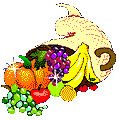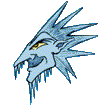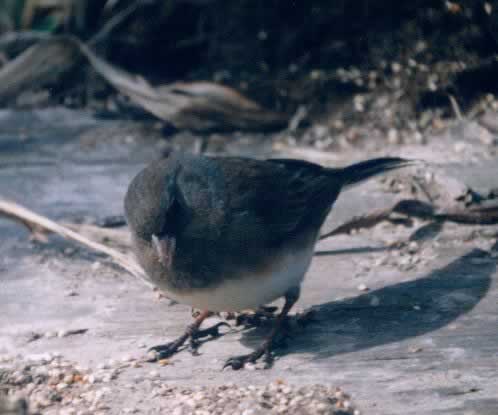|
|
Canku Ota |
|
|
(Many Paths) |
||
|
An Online Newsletter Celebrating Native America |
||
|
October 19, 2002 - Issue 72 |
||
|
|
||
|
The Legend of the Snowbirds |
||
|
an Ojibway legend
|
||
|
|
 Many
years ago, there lived in the Ojibway encampment at the mouth of the Kaministiqua
River, a beautiful young Indian maiden, beloved by all, and talented in
the art of handicrafts. Many beautiful gifts were fashioned by the clever
fingers of White Dove. White Dove made some lovely gifts of silver, found
that summer on a trip to Silver Island. Two days before the great Indian
feast of Thanksgiving, White Dove and her boy friend, Nanokarsi, set out
to take the ornaments of silver to White Dove's grandmother, who lived
a day's journey away in the foothills of the "Nor-Westers" mountain
range. Taking only a light lunch for their midday meal, the young couple
bid their families goodbye, promising to return in time for the great
feast. Many
years ago, there lived in the Ojibway encampment at the mouth of the Kaministiqua
River, a beautiful young Indian maiden, beloved by all, and talented in
the art of handicrafts. Many beautiful gifts were fashioned by the clever
fingers of White Dove. White Dove made some lovely gifts of silver, found
that summer on a trip to Silver Island. Two days before the great Indian
feast of Thanksgiving, White Dove and her boy friend, Nanokarsi, set out
to take the ornaments of silver to White Dove's grandmother, who lived
a day's journey away in the foothills of the "Nor-Westers" mountain
range. Taking only a light lunch for their midday meal, the young couple
bid their families goodbye, promising to return in time for the great
feast.
The wind howled about them, whipping the heavy snow into enormous drifts and blinding their vision. They wandered hopelessly until nightfall. Then cold, exhausted and hungry, they laid down in the shelter of a large rock, embracing each other to share their body warmth. The Thanksgiving Feast was at its height when the old Chief, Running Deer, solemnly announced the two had not returned and that he feared they were lost in the storm. All the braves volunteered to go in search of them. After four days the searchers came upon the couple, still embraced, but sleeping the Great Sleep, from which there is no awakening! The braves knelt beside them and called upon Nanna Bijou, their Spirit God, to breathe new life in their bodies.
As they flew into the air, they darted from left to right, making the snowy plumage of their breasts and under their wings and tail quite visible to the on-looker.
Print and Color Your Own Snowbird |
|
|
|
Dark-eyed Junco
(Junco hyemalis)
|
|
Description 5-6 1/4" (13-16 cm). This species shows much geographic variation in color. Typically, male of western population ("Oregon Junco") has black hood, chestnut mantle, white underparts with buff sides. Eastern male ("Slate-colored Junco") is dark slate-gray on head, upper breast, flanks, and upperparts, with white lower breast and belly. Both forms have pink bill and dark gray tail with white outer tail feathers conspicuous in flight. The pine forests of the Black Hills in western South Dakota and eastern Montana have an isolated population ("White-winged Junco") similar to the eastern form but with 2 white wing bars and extensive white outer tail feathers. Birds of the Southwest ("Gray-headed Juncos") are gray overall, with a reddish-brown back. Female "Oregon Junco" has gray hood; females of all forms less colorful. Voice Ringing metallic trill on the same pitch. Members of a flock may spread out widely, keeping in contact by constantly calling tsick or tchet. Also a soft buzzy trill in flight. Habitat Openings and edges of coniferous and mixed woods; in winter, fields, roadsides, parks, suburban gardens.
Range Breeds from Alaska east across Canada to Newfoundland, south to mountains in Mexico and Georgia. Winters south to Gulf Coast and northern Mexico. Discussion This lively territorial bird is a ground dweller and feeds on seeds and small fruits in the open. It also moves through the lower branches of trees and seeks shelter in the tangle of shrubs. Until recently the many geographical forms of this bird were considered separate species, but since they interbreed wherever their ranges meet, they are now considered one species.
|
|
|
||
|
|
||
| Canku Ota is a free Newsletter celebrating Native America, its traditions and accomplishments . We do not provide subscriber or visitor names to anyone. Some articles presented in Canku Ota may contain copyright material. We have received appropriate permissions for republishing any articles. Material appearing here is distributed without profit or monetary gain to those who have expressed an interest. This is in accordance with Title 17 U.S.C. section 107. | ||
|
Canku Ota is a copyright © 2000, 2001, 2002 of Vicki Lockard and Paul Barry. |
||
 |
 |
|
|
The "Canku Ota - A Newsletter Celebrating Native America" web site and its design is the |
||
|
Copyright © 1999, 2000, 2001, 2002 of Paul C. Barry. |
||
|
All Rights Reserved. |
||
 Shortly
after they had finished their noon lunch, they were unpleasantly surprised
by a chilling gust of wind. Immediately Nanokarsi climbed to the top
of a giant pine tree and looking north saw billows of black, ominous
clouds. Fearful of the storm, he urged White Dove to run as fast as
her legs could carry her but they had gone only a short distance, when
the storm burst upon them in all its fury!
Shortly
after they had finished their noon lunch, they were unpleasantly surprised
by a chilling gust of wind. Immediately Nanokarsi climbed to the top
of a giant pine tree and looking north saw billows of black, ominous
clouds. Fearful of the storm, he urged White Dove to run as fast as
her legs could carry her but they had gone only a short distance, when
the storm burst upon them in all its fury!  The
Great Spirit told them he could not bring them back as they were now
in the home of the Great Manitou, neither could he forbid the Snow Spirit
to come again. Nanna Bijou did, however, promise he would give them
a sign that would forever warn them of the Snow Spirit approaching and,
if heeded, would bring them no harm. As the braves watched, they were
amazed to see the bodies of White Dove and Nanokarsi slowly disappear
into the snow and, there where they had lain, appeared two pretty little
soft grey birds with striped heads!
The
Great Spirit told them he could not bring them back as they were now
in the home of the Great Manitou, neither could he forbid the Snow Spirit
to come again. Nanna Bijou did, however, promise he would give them
a sign that would forever warn them of the Snow Spirit approaching and,
if heeded, would bring them no harm. As the braves watched, they were
amazed to see the bodies of White Dove and Nanokarsi slowly disappear
into the snow and, there where they had lain, appeared two pretty little
soft grey birds with striped heads!  Also
known as the snowbird, the Junco can be found visiting your bird feeder
as soon as the snow starts to fall.
Also
known as the snowbird, the Junco can be found visiting your bird feeder
as soon as the snow starts to fall. Nesting
3-6 pale bluish or greenish eggs, with variegated blotches concentrated
at the larger end, in a deep, compact nest of rootlets, shreds of bark,
twigs, and mosses, lined with grasses and hair, placed on or near the
ground, protected by a rock ledge, a mud bank, tufts of weeds, or a
fallen log.
Nesting
3-6 pale bluish or greenish eggs, with variegated blotches concentrated
at the larger end, in a deep, compact nest of rootlets, shreds of bark,
twigs, and mosses, lined with grasses and hair, placed on or near the
ground, protected by a rock ledge, a mud bank, tufts of weeds, or a
fallen log.